Good News: the Containment Measures are Working
post by Shmi (shminux) · 2020-03-17T05:49:12.516Z · LW · GW · 16 commentsContents
New cases dropping New cases leveling off New Cases switching from exponential to linear Inconclusive, but apparently sub-exponential None 16 comments
After weeks and months of rather drastic measures we can see the glimpse of how the lockdowns are making a difference. Here are the snapshots from worldometer:
New cases dropping
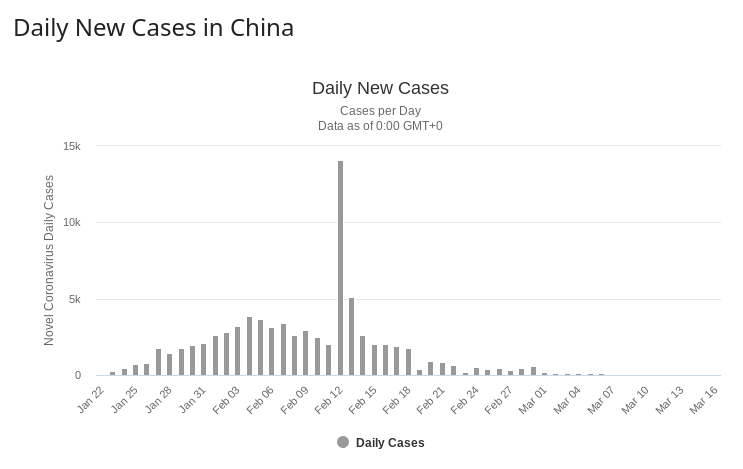
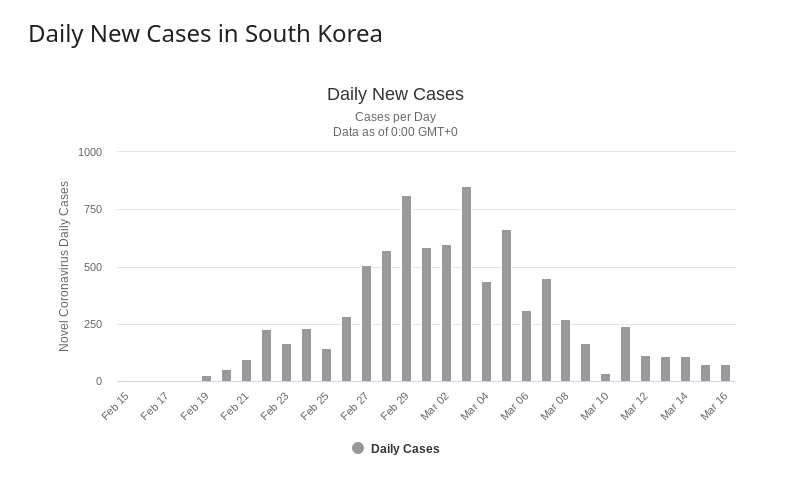
New cases leveling off
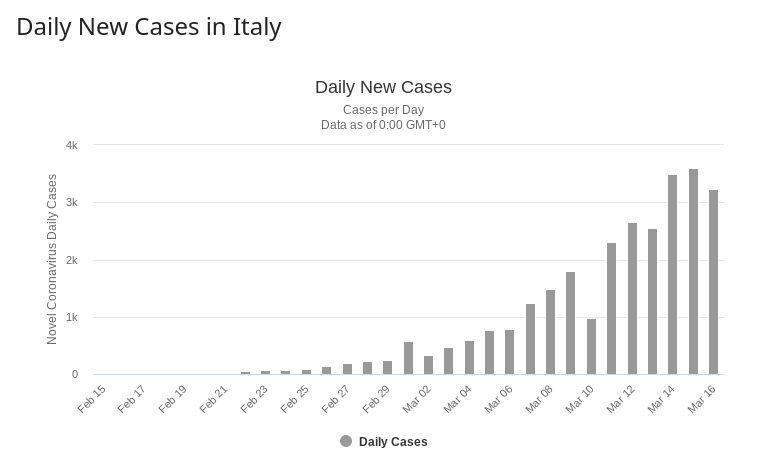
New Cases switching from exponential to linear
Japan: no Worldometer breakdown, data from Wikipedia
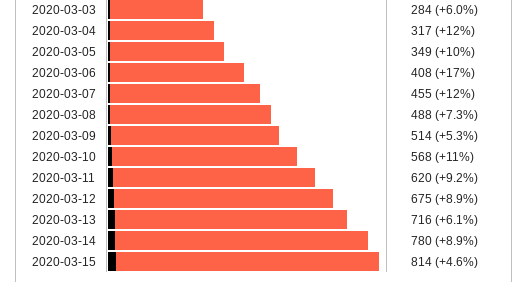
Inconclusive, but apparently sub-exponential
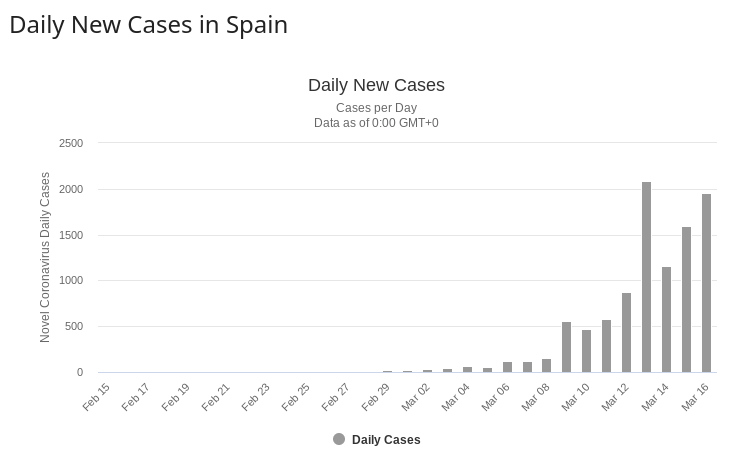
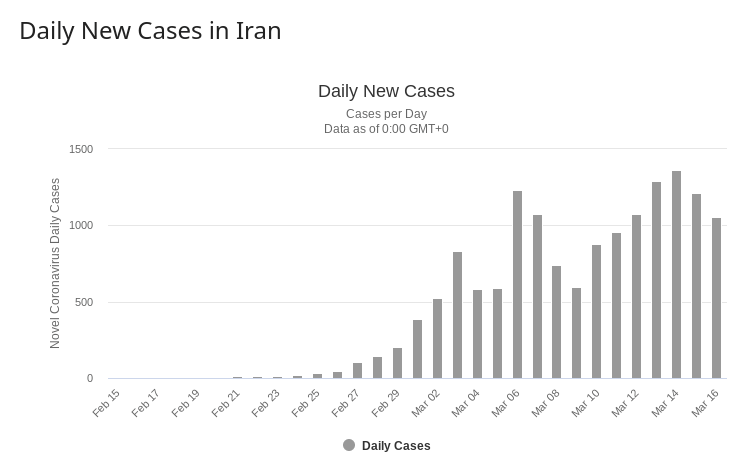
What does it mean for the future? That it takes about a week of a severe lockdown to switch from the exponential growth to linear, about two weeks to switch to leveling off, and three to four weeks to start seeing a meaningful decline. If this pattern holds, then the dire projections of millions dying would not come to pass. The overall toll is likely to be around 100,000 in 2020 if most countries adopt the China/Korea/Italy/Spain-level measures. Moreover, the worst of the pandemic, or at least of this first wave, will be over in 2-3 months, as long as the containment measures are in place, and the countries and jurisdictions that are proactive enough will not have to resort to the worst of the ICU triage any time soon.
This was the good news. The bad news is that this is not sustainable in the medium to long term, given the impact of the measures on the economy, mobility and lifestyle. But maybe the effort to flatten the curve is not in vain. The question is, what's next? Who knows? A viable vaccine is at least a year away, the ICU bed count ramp up may help, some of the social distancing measures such as deliveries, takeouts, telecommuting may prove sustainable enough, but that doesn't seem like nearly enough in the long term.
16 comments
Comments sorted by top scores.
comment by Isnasene · 2020-03-21T23:02:55.102Z · LW(p) · GW(p)
I shared this post with some of my friends and they pointed out that, as of 3/21/2020, the Italy and Spain curves no longer look as optimistic:
- On March 16, cases in Italy appeared to be leveling off. Immediately following that, they broke trend and began rising again. March 16 had ~3200 daily cases. March 20 has ~6000.
- Spain appeared to be leveling off up through March 17th (~1900 daily cases). But on March 18th, it spiked to ~3000. As of March 20th, things may be leveling off again but I wouldn't draw any conclusions
- Iran's daily cases have stayed flat for a pretty long period of time now -- at around 1000 per day. This seems like it should be good news, tho I'm not sure how good: Since March 8, Iran's death rate (closed cases) has been steadily rising from 8% to 17.5%
↑ comment by Shmi (shminux) · 2020-03-22T01:22:24.124Z · LW(p) · GW(p)
Yeah, that was optimistic, apparently. Woeful underreporting everywhere except Korea and less so Germany and Canada.
comment by Bucky · 2020-03-17T13:48:12.752Z · LW(p) · GW(p)
The most interesting case to me is South Korea who have managed to achieve containment without mass lockdowns - instead they have an aggressive testing policy such that only 3% of tests are positive.
Replies from: jmh↑ comment by jmh · 2020-03-17T16:10:25.523Z · LW(p) · GW(p)
True but apparently the people there have been, for the most part, been really good about social distancing practices, and I suspect general hygiene practices as well.
The do seem to have a problem with some of their religious groups that want to congregate but perhaps they will get the memo soon too.
But to be clear, I think their example makes clear that the hammer of authoritarian lock-down is not the only solution and the less authoritarian democracies can address the problem within the context of an individual freedom regime.
comment by jimrandomh · 2020-03-17T08:14:00.212Z · LW(p) · GW(p)
What does it mean for the future? That it takes about a week of a severe lockdown to switch from the exponential growth to linear, about two weeks to switch to leveling off, and three to four weeks to start seeing a meaningful decline.
This is because of the incubation period (3-14d) and the delay between people becoming symptomatic and getting tested. The reduction in transmissions is immediate, it just takes awhile to notice.
Replies from: jmh↑ comment by jmh · 2020-03-17T16:08:39.466Z · LW(p) · GW(p)
Does anyone have any reasonably good estimate on what the average incubation period is?
Replies from: jimrandomh↑ comment by jimrandomh · 2020-03-17T16:24:47.215Z · LW(p) · GW(p)
In this post [LW · GW] I collected papers which estimate the incubation period (time from exposure to symptom onset) and the serial interval (time from exposure to infecting the next person in the chain). Studies get varying results because they're done in different populations and have methodological differences, but find reasonably similar medians. A few of them also provide full distributions over incubation periods and serial intervals.
comment by DanArmak · 2020-03-17T10:32:46.686Z · LW(p) · GW(p)
Moreover, the worst of the pandemic, or at least of this first wave, will be over in 2-3 months, as long as the containment measures are in place,
What's the mechanism behind the slowing growth? When we let up on our measures (quarantine etc) why will the growth not speed up again, until most of the population have been exposed?
Replies from: petter-wingren↑ comment by Petter Wingren (petter-wingren) · 2020-03-17T14:16:59.157Z · LW(p) · GW(p)
I think you are absolutely right. Containment measure can decrease the amount of individuals with severe symptoms at any given time and thereby not overload hospitals too much. End result will be less casualties but longer pandemic.
Replies from: DanArmak↑ comment by DanArmak · 2020-03-17T15:22:07.095Z · LW(p) · GW(p)
I think you are absolutely right.
I'm not quite that sure I'm right. (I was genuinely asking about the mechanism, not claiming there isn't one!) I am not an expert and there are other epidemics that die out without having infected most of the population, like indeed seasonal flu and cold, and I don't know all the causes of that that might apply here.
End result will be less casualties but longer pandemic.
It could be worse; 'less overall casualties' relies on the reasonable but unproven assumptions of:
- Reliable natural immunization, i.e. people won't (often) catch it twice
- Few or no mutations that act as a 'second wave' or in the extreme case like the seasonal flu that happens every year
- (Most) people with light/no symptoms don't end up with long term complications, or a persistent virus that can reactivate later
comment by orthonormal · 2020-03-17T18:50:37.271Z · LW(p) · GW(p)
Tests of antivirals and other treatments may come along sooner than a vaccine. That's something to hope for.
comment by buckb · 2020-03-18T17:47:26.937Z · LW(p) · GW(p)
This article is now blocked by Facebook! Congratulations! In fact, the whole oath / sign in via Facebook is inop.
Replies from: Raemon, shminux↑ comment by Shmi (shminux) · 2020-03-18T00:18:25.051Z · LW(p) · GW(p)
Hah! How could just one of many Covid posts here be blocked?!
Replies from: habryka4↑ comment by habryka (habryka4) · 2020-03-18T00:21:22.736Z · LW(p) · GW(p)
All of LessWrong was blocked for about an hour from Facebook, but the issue appears to now be fixed.
Context: https://twitter.com/guyro/status/1240063821974138881
Replies from: shminux↑ comment by Shmi (shminux) · 2020-03-18T00:37:11.437Z · LW(p) · GW(p)
Ah, that makes a lot more sense!